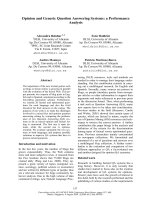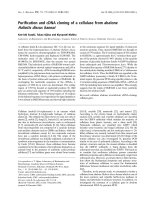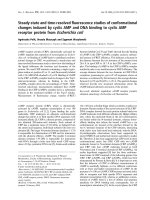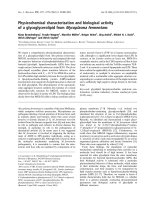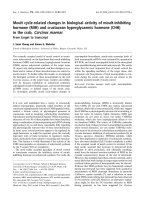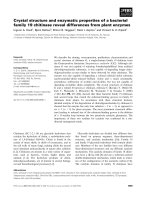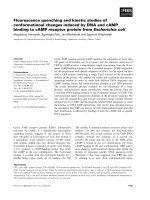báo cáo khoa học: "Opinion leaders and changes over time: a survey" potx
Bạn đang xem bản rút gọn của tài liệu. Xem và tải ngay bản đầy đủ của tài liệu tại đây (773.62 KB, 6 trang )
RESEARC H Open Access
Opinion leaders and changes over time: a survey
Gaby Doumit
1*
, Frances C Wright
2
, Ian D Graham
2,3
, Andrew Smith
2
and Jeremy Grimshaw
4
Abstract
Background: Opinion leaders represent one way to disseminate new knowledge and influence the practice
behaviors of physicians. This study explored the stability of opinion leaders over time, whether opinion leaders
were polymorphic (i.e., influencing multiple practice areas) or monomorphic (i.e., influencing one practice area), and
reach of opinion leaders in their local network.
Methods: We surveyed surgeons and pathologists in Ontario to identify opinion leaders for colorectal cancer in
2003 and 2005 and to identify opinion leaders for breast cancer in 2005. We explored whether opinion leaders for
colorectal cancer identified in 2003 were re-identified in 2005. We examined whether opinion leaders were
considered polymorphic (nominated in 2005 as opinion leaders for both colorectal and breast cancer) or
monomorphic (nominated in 2005 for only one condition). Social-network mapping was used to identify the
number of local colleagues identifying opinion leaders.
Results: Response rates for surgeons were 41% (2003) and 40% (2005); response rates for pathologists were 42%
(2003) and 37% (2005). Four (25%) of the surgical opinion leaders identified in 2003 for colorectal cancer were re-
identified in 2005. No pathology opinion leaders for colorectal cancer were identified in both 2003 and 2005. Only
29% of surgical opinion leaders and 17% of pathology opinion leaders identified in the 2005 survey were
considered influential for both colorectal cancer and breast cancer. Social-network mapping revealed that only a
limited number of general surgeons (12%) or pathologists (7%) were connected to the social networks of identified
opinion leaders.
Conclusions: Opinion leaders identified in this study were not stable over a two-year time period and generally
appear to be monomorphic, with clearly demarcated areas of expertise and limited spheres of influence. These
findings may limit the practicability of routinely using opinion leaders to influence practice.
Background
Faced with consistent evidence about evidence-practice
gaps, there is continued policy and research interest in
strategies to promote evidence uptake to improve qual-
ity of care and patient safety. Early diffusion of innova-
tion research highlighted the importance of influential
individuals ("opinion leaders”) within communities in
promoting the rapid uptake and spread of innovations
[1,2]. Rogers acknowledged that opinion leaders play a
critical role in shepher ding an innovation to that point
at which a critical number of members of a social net-
work have adopted the innovation such that further
increases in the adoption become self-sustained [3].
These findings led to attemp ts to identify and recru it
opinion leaders to promote evidence uptake.
There a re four approaches to identifying opinion lea-
ders: sociometri c methods, key-informant methods, self-
designating methods, and observation [ 3]. Sociometric
methods involve exte nsive analyses of leadership nomi-
nations within members of a peer group and were
employed in the present study. The majority of studies
of opinion leaders in healthcare have used the Hiss
instrument, a sociometric survey[4,5]. The Hiss instru-
ment was developed based upon interviews with family
doctors in Michigan that identified three characteristics
of opinion leaders, namely that they encourage learning
and enjoy sharing their know ledge, are clinical experts
considered up-to-date, and treat others as equals[5-8]. It
asks respondents to identify individuals who have each
of these characteristics separately; individuals are con-
sidered opinion leaders if they are identified as having
* Correspondence:
1
Institute of Dermatology and Plastic Surgery, Cleveland Clinic, Cleveland,
OH, USA
Full list of author information is available at the end of the article
Doumit et al. Implementation Science 2011, 6:117
/>Implementation
Science
© 2011 Doumit et al; licensee BioMed Central Ltd. This is an Open Access article distributed under the terms of the Creative Commons
Attribution License (http://creativecommons .org/licenses/by/2.0), which permits unrestricte d use, distribution, and reproduction in
any medium, provided the original work is properly cited.
all three characteristics. The Hiss instrument has been
used widely in dissemination and implementation
research. Grimshaw and colleagues tested the conver-
gent validity of the Hiss instrument and observed that
identified opinion leaders were more likely than other
respondents to possess hypothesized characteristics of
opinion leaders (identifi ed from diffusion of innovations
and social influence theories)[9]. In a recent systematic
rev iew, 9 o ut of 12 randomized trials of opinion leader-
ship used the Hiss instrument to identify opinion lea-
ders [4]; all demonstrated short-term improvements in
quality of care. While the use of opinion leaders appears
to be a potentially useful dissemination and implemen-
tation strategy, there remain many important unan-
swered questions. First, the stability over time of
perceptions about who is c onsidered an opinion leader
within a community has never been assessed. Second, it
is important to know whether those considered opinion
leaders are perceived to exert influence regarding multi-
ple practice areas (polymorphic) or a single practice area
pertaining to a particular disease (monomorphic). Third,
the extent of influence of opinion leaders has rarely
been described or mapped using social-network analysis.
In this study, we have built upon the work of Wright
et al., who surveyed general surgeons and pathologists
in Ontario to determine who were the opinion leaders
for colorectal cancer in 2003[5]. They surveyed all eligi-
ble general surgeons (n = 594) and pathologists (n =
358) in Ontario. Return rates were 41% for surgeons
and 42% for pathologists [5]. No opinion leaders were
identified in 39 of 81 (48%) hospitals. In the remaining
hospitals, 16 surgeon and 6 pathologist local opinion
leaders were identified. We resurveyed the same Ontario
surgeons and pathologists in 2005 to determine i f opi-
nion leaders remain stable over t ime, whether opinion
leaders are polymorphic or monomorphic, and to deter-
mine the reach of opinion leaders’ influence using
social-network mapping.
Methods
This study i s embedded in a randomized trial [10] com-
paring the influence of formal continuing medical edu-
cation given by a provincial expert with or without
reinforcement by local opinion leaders on the optimiza-
tion of lymph node assessment in colorectal cancer
(ISRCTN56824239). For the trial, surgeon and patholo-
gist opinion leaders for colorectal cancer were ident ified
using the Hiss survey instrument in 2003.
In 2005 we resurveyed the same pathologists and sur-
geons using the Hiss instrument to identify opinion lea-
ders for the management of colorect al and b reast
cancer. The survey also asked about demographic infor-
mation, including gender, age, numbers of years in prac-
tice, practice location, nature of practice, and estimated
percent age of their clinical volume that related to color-
ectal c ancer and breast cancer (Additional file 1, Addi-
tional file 2).
Survey samples
To generate the mailing list for the 2 005 survey, the
2003 physician survey list was reviewed. Physicians who
declined to participate in the 2003 survey were excluded
(n = 118), as were physicians whose clinical practice did
not include any oncology (e.g., vascular, pediatric, and
cardio-thoracicsurgeons),wereretired,werenotpre-
sently practicing in Ontario, had died, or if their practice
no longer included colorectal cancer man agement (n =
43). In total, the 2005 survey was mailed to 480 general
surgeons and 311 pathologists. Physicians were invited
to return the survey using an enclosed stamped
addressed envelope or a return fax number. An addi-
tional three mailings were completed.
If surveys were returned with an incorrect address and
if we were unable to identify the correct address by
searching the Royal College of Physicians and Surgeons
of Canada online directory, Royal College of Physicians
and Surgeons of Canada website, 411 Canada website,
and the worldwide web , then these physicians were
excluded.
Physicians were identified as opinion leaders if they
were nominated as knowledgeable, as an educator, and
as humanistic by at least one respondent.
Opinion leader stability over time
We determined the proportion of colorectal cancer opi-
nion leaders who were identified in the 2003 survey [5]
that were re-identified as colorectal cancer opinion lea-
ders in the 2005 survey.
Polymorphism or monomorphism of opinion leaders
Monomorphism describes the situation where an opi-
nio n leader is considered influential in only one clinical
area. Polymorphism represents a condition where an
opinion leader is considered influential in multiple clini-
cal areas. In this survey, if a physician was nominated as
an opinion leader for either colorectal cancer or breast
cancer, they were considere d to be monomorphic but if
they were nominated as an opinion leader for both col-
orectal cancer and breast cancer, then they were consid-
ered to be polymorphic.
Assessment of opinion leaders’ influence using social-
network analysis
Social-networks plots were used to descriptively map the
findings. Social-networks plots map the relationships
(ties) between individuals (nodes) in a particular social
network [11]. The nodes in the present network repre-
sent the survey respondents and opinion leaders, while
Doumit et al. Implementation Science 2011, 6:117
/>Page 2 of 6
the ties between the nodes illustrate the relationships
among them.
The social-networks plots for the 2003 and 2005 sur-
veys are made up of the general surgeon and pathologist
respondents to the 2003 and 2005 surveys, respectively,
and their nominated opinion leaders for colorectal can-
cer. They are tied together by the surgeons’ and pathol-
ogists’ relationships to their nominated colorectal cancer
opinion leader.
Plotting social ne tworks provides a visual representa-
tion of the relationships between responde nts and iden-
tified opinion leaders. Analysis of the surgeons’ and
pathologists ’ social networks will help expose the pat-
tern of links and help draw inferences about the social
structure within which opinion lea ders are embedded.
The number of links between respondents and opinion
leaders reflect the number of respondents who identified
opinion le aders in their network. The strength of impact
of an opinion leader within his or her medical commu-
nity will come from the degree to which the opinion
leader is at the center of many relationships. The more
connected the individuals in the network, the more
likely the information will readily diffuse [3].
Statistical analysis
Analysis was performed using the SAS 9.1 statistical
software package (SAS Institute, Inc., Cary, NC, USA).
A chi-square or Fisher exact test was used to evaluate
differences between categorical variables, and a student
t -test was used to evaluate differences between means
for continuous data. Medians were compared with the
Wilcoxon two-sample test. Statistical significance was
defined as p < .05, and all tests of significance were two
tailed. In addition, PowerPoint
®
(Microsoft Corporation,
Redmond, WA, USA) was used to plot the social net-
works of general surgeons and pathologists.
Ethical approval for the project was obtained from the
Ottawa Hospital Research Ethics Board.
Results
Survey returns
After four mailings, 37.2% (111/298) of eligible patholo-
gists and 39.8% (177/445) of eligible general surgeons
returned completed 2005 surveys.
Of the 152 pathologist respondents in 2003, 86
responded to the 2005 surv ey, for a recurrent response
rate of 57%. For general surgeons, t he recurrent
response rate was 56%. There are no statistical differ-
ences between both groups of physicians regarding sur-
vey response (chi-square degrees of freedom = 1, 0.53; p
= .47) and recurrent response ratio (chi-square degrees
of freedom = 1, 0.01; p = .91). Thirty-one physicians
returned a blank survey, which were considered to be
refusals. When addresses of physicians in 2005 were
compared to their addresses in 2003, there was a 3.3%
and 5 .5% change in pathologists’ and general surgeons’
addresses, respectively.
Demographic characteristics of 2005 respondents
Fifty-nine percent of pathologists and 87% of general
surgeons were male. There are significantly more males
among general surgeons (p < .0001). The mean age in
years for pathologists and general surgeons was 51.8 and
50.9, respectively. Colorectal cancer made up 10% and
15% of the pathologist and general surgeon respondents’
clinical volume, respectively (p < .001). Breast cancer
consisted of 10% of the pathologist and general surgeon
respondents’ estimated median clinical volume. Approxi-
mately 80% of pathologist and general surgeon respon-
dents worked in urban centers.
Demographic characteristics of 2005 nonrespondents
Four hundred and fifty-five physicians did not respond
to our survey despite four mail outs. When sex, age, and
mean years of clinical practices of nonrespondents were
compared to respondents, there were no statistically sig-
nificant differences.
Opinion leaders’ identification
Colorectal cancer
Physicians nominated by their community colleagues as
knowledgeable, educators, and humanistic and whose
advice they valued on colorectal cancer were considered
opinion leaders for colorectal cancer. In the 2005 survey,
6 pathologi sts and 17 gener al surgeons were nominated
as opinion leaders for co lorectal cancer. Pathologist opi-
nion leaders for colorectal cancer had a mean age of
50.7 years and were 67% male. They had on average
17.5 years of clinical experience, and colorectal cancer
made up 17.5% of their clinical practice. Most of them
(83%) worked in urban centers. Of the surgical opinion
leaders for colorectal cancer, 76% were male and the
mean age was 45 years. They had a mean of 12.5 years
of clinical practice, and colorectal cancer made up 30%
of their practic e. Fifty-nine percent o f the surgical opi-
nion leade rs worked in urban cent ers. No statistica l dif-
ference in all characteristics for colorectal cancer-
specific opinion leaders was reached between patholo-
gists and general surgeons (.12 ≤ p ≤ .63). I n addition,
there was no statistical difference between opinion lea-
ders for colorectal cancer and survey participants on all
characteristics examined (.08 ≤ p ≤ .94).
Breast cancer
In the 2005 survey, 13 surgical and 1 pathologist opi-
nion leaders for breast cancer were identified.
Stability over time of opinion leaders for colorectal cancer
No opinion leaders identified by pathologists in 2003
were re-identified in 2005. Five pathologists not
Doumit et al. Implementation Science 2011, 6:117
/>Page 3 of 6
identified as opinion leaders in the 2003 survey were
identified as such in the 2005 surv ey. Four (25%) of the
16 opinion leaders identified in 2003 by general sur-
geons were re-identified in 2005 by the same respon-
dents. Eight surgeons were newly identified in the 2005
survey.
Monomorphism or polymorphism of opinion leaders
In the 2005 survey, 13 surgical opinion leaders for
breast cancer were identified. Of the 13 surgeons nomi-
nated as opinion leaders for breast cancer, five were also
nominated as opinio n leaders for color ectal ca ncer
(29%). Pathologists identified only one opinion leader
for breast cancer who was also an opinion leader for
colorectal cancer (17%).
Mapping social networks for opinion leaders in colorectal
cancer
There was also a scarcity of links among the opinion
leaders for colorectal cancer and the survey respondents
when the social-network analysis was completed for
both 2003 an d 2005. Furthermore, a limited number of
general surgeons (2003 survey: 31/236 = 13%; 2005 sur-
vey: 21/177 = 12%) and pathologists (2003 survey: 4/152
= 3%; 2005 survey: 8/111 = 7%) were connected to the
networks (Figures 1 and 2).
Discussion
Summary of key findings
This study in two professional groups has demonstrated
that opinion leaders did not remain the same over the
two-year study period, that opinion leaders were
perceived by the community to have very clearly demar-
cated areas of expertise and not be polymorphic, and
that the sphere of influence attributed to opinion leaders
in the fields of surgery and pathology is not extensive.
We found that none of the pathology opinion leaders
and only 25% of the surgical opinion leaders for colorec-
tal cancer who were identified in 2003 were re-identified
by their pee rs in 2005. Further, eight surgeons a nd five
pathologists were newly identified as opinion leaders in
2005. Together, these findings suggest the fluidity of
opinion leaders and social networks.
These results imply that opinion leaders identified by
the Hiss criteria need to be re-identified at least every
two years if an opinion leader’s influence is to be used
in a knowledge-translation intervention. We are not
entirely clear why perceptions of who are opinion lea-
ders are so transient. It may be that an opinion lea der’s
influence simply does not last very long. Alternatively,
perhaps the Hiss opinion-leader identification instru-
ment is not reliable. Interestingly, the test-retest reliabil-
ity for the Hiss instrument has never been assessed in
previous research. Hence, it is possible that this Hiss
instrument will yield different opinion leaders on suc-
cessiv e identification surveys. It is also possible that the
formal identification of an opinion leader interferes with
the opinion leader’s future influence. Previous research
has reported concerns about potential changes in the
relationship between opinion leaders and other physi-
cians in their networks once such indiv iduals have been
formally identified and subsequently trained to
Figure 1 Colorectal cancer surgeons’ and pathologists’ social network in 2003. Only 13% (31/236) of surgeon and 3% (4 /152) of
pathologists’ respondents to the 2003 survey are linked to the colorectal cancer opinion-leader social network in Ontario
Doumit et al. Implementation Science 2011, 6:117
/>Page 4 of 6
disseminate evidence-based research[12,13]. Locock
(2001) has commented that there is a difficult balance
to be struck for opinion leaders–their enthusiasm for a
project may win others over and result in beneficial
practice changes in some, but equally, this enthusiasm
may single out such individuals as too diffe rent or radi-
cal and thereby undermine local influence. So by trying
to formalize the role of opinion leaders as an educa-
tional channel, there is a danger that their previous
informal influence may be lost [12].
The monomorphic nature of opinion leaders has been
previously described in qualitative studies but not, as far
as we are aware , in quanti tative studies for this group of
specialists [10,14]. In thi s study, only 29% of surgical
opinion leaders and 17% of patholo gy opinion leaders
were considered influential for both colorectal cancer
and breast cancer. This has important pract ical implica-
tions for knowledge-translation activities involving opi-
nion leaders in that interventions targeting different
clinical conditions will require repeated identification
surveys to identify relevant local opinion leaders.
Networks within which physicians are embedded have
been shown to have an important influence on their
attitudes and healthcare behaviors [15]. Marsden and
Friedkin have stated that “the proximity of two actors in
social networks is associated with the occurrence of
interpersonal influence between the actors,” where influ-
ence refers not just to conscious attempts to change
behavior by using power or persuasion but also involves
unconscious processes such as imit ation, contagion, or
comparison [16]. Analysis of the surgeons’ and patholo-
gists’ social networks in the present study involved
mapping relationships between survey responders and
opinion leaders in order to expose the pattern of links
and to help draw i nferences about the social structure
within which opinion leaders are embedded. General
surgeons in Ontario appear to be more connected to
their provincial colleagues than their counterparts in
pathology. This observation suggests that g eneral sur-
geons might be more primed for an opinion leader
intervention than would pathologists. However, in
Wright et al.’s (2004) intervention, it appe ared that th e
influence of the local opinion leader had little impact on
the number of lymph nodes assessed, which could be
explained by their limited social network [10].
For the present work, there are a number of limita-
tions. The first limitation was the low response rates,
which lead to concerns about the generalizability of con-
clusions. However, our response rates were similar to
response rates reported for other surveys using the Hiss
instrument within both randomized trials and observa-
tional studies. While it is always pref erable to see higher
response rates, rates of this m agnitude are acceptable
for mail-out surveys, even with multiple reminders, so
our response rates were expected and were consistent
with those achieved in the 2003 survey. Concerns about
nonresponse bias were a ttenuated by the observed lack
of difference be tween participants and nonparticipants
(in the second survey) with respect to sex, age, and clin-
ical experience. The second limitation was that 5% o f
pathologists and 3% of surgeons changed hospitals
between 2003 and 2005 and may have disrupted local
social networks. However, as the number of address
changes encountered appears to be low, we believe that
Figure 2 Colorectal cancer surgeons’ and pathologists’ social network in 2005. Only 12% (21/177) of surgeon and 7% (8 /111) of
pathologists respondents to the 2005 survey are linked to the colorectal cancer opinion-leader social network in Ontario
Doumit et al. Implementation Science 2011, 6:117
/>Page 5 of 6
the impact of such misclassification bias is likely to be
minimal. Furthermore, by limiting t he population used
in the 2005 survey to the 2003 cohort of physicians, we
think that contamination of our study population by
incoming new specialists who were not exposed to the
trial intervention was reduced. Finally, turnover of sur-
geons and pathologists is inevitable in the real world. A
third limitation of the study is the reliability of the sur-
vey results, which is difficult to assess as no test-retest
for the Hiss instrument has previously been performed.
We suggest that further research on the opinion-lea-
der concept should focus on determining the reliability
of the Hiss instrument as an opinion-leader identifica-
tion tool. At the present, there is no way of determining
whether the i nability to replicate the results of the 2003
Hiss instrument survey by Wright et al. over two yea rs’
time is due to t he short half-life of the opinion leaders
or whether it is due to low reliability of the Hiss instru-
ment. Furthermore, most research that has been con-
cerned with opinion-leader selection and effectiveness in
improving health professionals’ behavior has not
explored the extent of the reach of social networks
within which the opinion leaders are embedded, which
could be an important factor in the effectivenes s of opi-
nion-leader interventions.
Conclusion
In conclusion, we have found that, for two professional
groups in Ontario, opinion leaders did not remain the
same over a two-year time period. Opinion leaders were
perceived to have very clearly demarcated areas of
expertise (i.e., not polymorphic) and/or have limited
spheres of influence by the respondents of this survey.
Additional material
Additional file 1: Hiss survey for pathologists. The Hiss survey
instrument used to identify opinion leaders for the management of
colorectal and breast cancer among pathologists.
Additional file 2: Hiss survey for general surgeons. The Hiss survey
instrument used to identify opinion leaders for the management of
colorectal and breast cancer among general surgeons.
Acknowledgements and funding
KT ICEBERG Group (Improved Clinical Effectiveness through
Behavioural Research). A group funded by the Ontario Ministry of Health
and Long-term Care and the Canadian Institutes of Health Research fully
funded the present study.
Author details
1
Institute of Dermatology and Plastic Surgery, Cleveland Clinic, Cleveland,
OH, USA.
2
Department of Surgery-General Surgery, Sunnybrook Health
Sciences Centre, Toronto, Canada.
3
Knowledge Translation and Public
Outreach Portfolio, Canadian Institutes of Health Research, Ottawa, Canada.
4
Clinical Epidemiology Program, Ottawa Health Research Institute, Ottawa,
Canada.
Authors’ contributions
GD participated in the design of the study, carried out the 2005 survey,
performed the statistical analysis, and drafted the manuscript. FCW carried
out the 2003 survey, participated in the design of the study, and helped to
draft the manuscript. IDG participated in the study’s design and coordination
and helped to draft the manuscript. AS participated in the 2003 survey,
participated in the design of the study, and helped to draft the manuscript.
JG participated in the study’s design and coordination and helped to draft
the manuscript. JG was the senior research supervisor.
All authors read and approved the final manuscript.
Competing interests
The authors declare that they have no competing interests.
Received: 13 December 2010 Accepted: 11 October 2011
Published: 11 October 2011
References
1. Lippet R, Watson J, Westley B: The Dynamic of Planned Change. Harcourt,
Brace and World, Inc., New York; 1958.
2. Wenrick JW, Mann FC, Morris W, Reilly A: Informal Education for Practicing
Physicians. J of Med Ed 1971, 46:4.
3. Rogers EM: Diffusion of innovations. New York: Free Press; 1995.
4. Doumit G, Gattellari M, Grimshaw J, O’Brien MA: Local opinion leaders:
effects on professional practice and health care outcomes. Cochrane
Database Syst Rev 2007, CD000125.
5. Wright FC, Ryan DP, Dodge JE, Last LD, Law CH, Smith AJ: Identifying
educationally influential specialists: issues arising from the use of
“classic” criteria. J Contin Educ Health Prof 2004, 24:213-226.
6. Rogers EM: Diffusion of innovation New York: Free Press; 1962.
7. Rogers EM: Lessons for guidelines from the diffusion of innovations. Jt
Comm J Qual Improv 1995, 21:324-328.
8. Hiss RG, Macdonald R, Davis WK: Identification of physician educational
influentials (EI’s) in small community hospitals. Proceedings of the
Seventeenth Annual Conference on Research in Medical Eduaction
Washington, DC; 1978, 283-288.
9. Grimshaw JM, Eccles MP, Greener J, Maclennan G, Ibbotson T, Kahan JP,
et al: Is the involvement of opinion leaders in the implementation of
research findings a feasible strategy? Implement Sci 2006, 1:3.
10. Wright FC, Law CH, Last LD, Klar N, Ryan DP, Smith AJ: A blended
knowledge translation initiative to improve colorectal cancer staging
[ISRCTN56824239]. BMC Health Serv Res 2006, 6:4.
11. Borgatti S, Foster P: The network paradigm in organizational research: a
review and typlogy. J Manag 2003, 29:991-1013.
12. Locock L, Dopson S, Chambers D, Gabbay J: Understanding the role of
opinion leaders in improving clinical effectiveness. Soc Sci Med 2001,
53:745-757.
13. Ryan DP, Marlow B, Fisher R: Educationally influential physicians: the need
for construct validation. J Contin Educ Health Prof 2002, 22:160-169.
14. Wright FC, Simunovic M, Coates A, Fitch M: Quality initiative in rectal
cancer strategy: a qualitative study of participating surgeons. J Am Coll
Surg 2006, 203:795-802.
15. West E, Barron DN, Dowsett J, Newton JN: Hierarchies and cliques in the
social networks of health care professionals: implications for the design
of dissemination strategies.
Soc Sci Med 1999, 48:633-646.
16. Marsden P, Friedkin N: Network studies of social influence. In Advances in
Social Network Analysis. Edited by: Wasserman S, Galaskiewiez J. London:
Sage; 1994:.
doi:10.1186/1748-5908-6-117
Cite this article as: Doumit et al.: Opinion leaders and changes over
time: a survey. Implementation Science 2011 6:117.
Doumit et al. Implementation Science 2011, 6:117
/>Page 6 of 6



